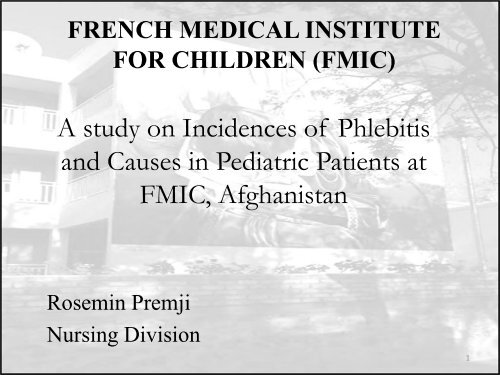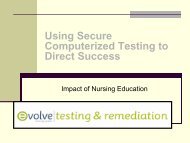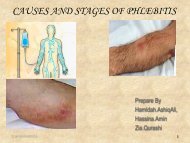french medical institute for children (fmic) - IUPUI
french medical institute for children (fmic) - IUPUI
french medical institute for children (fmic) - IUPUI
You also want an ePaper? Increase the reach of your titles
YUMPU automatically turns print PDFs into web optimized ePapers that Google loves.
FRENCH MEDICAL INSTITUTE<br />
FOR CHILDREN (FMIC)<br />
A study on Incidences of Phlebitis<br />
and Causes in Pediatric Patients at<br />
FMIC, Afghanistan<br />
Rosemin Premji<br />
Nursing Division<br />
1
Team Members<br />
MEMBERS:<br />
Ms. Hamidah Ismail<br />
Ms. Maria Muradi<br />
Ms. Doulat Hirani<br />
(Infection Control Nurse)<br />
(Infection Control Nurse)<br />
(Head of Quality Assurance Program)<br />
FACILITATORS:<br />
Ms.Rosemin Premji<br />
Dr. Alexander Lies<br />
(Administrator, Nursing Division)<br />
(Medical Director)<br />
2
Objectives of the study<br />
• To identify the occurrence and incidences of<br />
phlebitis at French Medical Institute <strong>for</strong> Children<br />
(FMIC).<br />
• To analyze the causes of phlebitis.<br />
• To present the strategy to minimizes the phlebitis<br />
in the future.<br />
3
Background of the Study<br />
• Peripherally inserted catheters are essential <strong>for</strong> infants &<br />
<strong>children</strong> in the neonatal intensive care unit and <strong>medical</strong><br />
surgical unit <strong>for</strong> medication administration, parenteral<br />
nutrition and blood transfusions.<br />
• An observational prospective study was carried out to<br />
identify the incidences of PIVCs infection, causes and<br />
recognize the strategies <strong>for</strong> its prevention in inpatient<br />
pediatric wards including ICU and <strong>medical</strong> surgical area<br />
of French Medical Institute <strong>for</strong> Children (FMIC) ,<br />
Afghanistan.
Background of the Study (…cont)<br />
• More than 250,000 IVD-related BSI occur in the<br />
United States each year, each associated with<br />
prolongation of hospital stay, a 12% to 25%<br />
attributable mortality, and an added cost to health<br />
care of $35000 (Maki, 2002).
Definition<br />
Phlebitis<br />
It is a condition in which inflammation of<br />
the intima of the vein occurs. It is<br />
characterized by pain and tenderness along<br />
the course of the vein, erythema, and<br />
inflammatory swelling with a feeling of<br />
warmth at the site.
Causes of Phlebitis:<br />
Causes of Phlebitis<br />
There are many causes of phlebitis. It could be chemical,<br />
mechanical or bacterial.<br />
• Chemical Phlebitis: The phlebitis occurs after<br />
administration of antibiotics or any infusion<br />
• Mechanical Phlebitis: Phlebitis occurs due to<br />
misplacement of PIVC<br />
• Bacterial Phlebitis: Phlebitis occurs due to proliferation<br />
of Bacteria. (Lynelle.F, 2002)
Stages of Phlebitis<br />
Stages of Phlebitis:<br />
There are four stages of phlebitis.<br />
• Stage I: Ertheyma ( redness at IV site) with or with out<br />
pain.<br />
• Stage II: Ertheyma(redness) with pain on IV site with<br />
or with out Edema.<br />
• Stage III: Redness, pain, swelling along with Streak<br />
<strong>for</strong>mation and palpable venous cord.<br />
• Stage IV: redness, pain, swelling along with Streak<br />
<strong>for</strong>mation and palpable venous cord >1 inch and<br />
Purulent discharge, and fever. (Lynelle.F, 2002)
Method <strong>for</strong> the study<br />
• A prospective quantitative study was done. A PIVC infection<br />
identification <strong>for</strong>m was developed to identify the occurrence.<br />
• 303 PIVCs placed in 150 pediatric patients from September<br />
2007 until November 2007 at French Medical Institute <strong>for</strong><br />
Children (FMIC) in Kabul, Afghanistan.<br />
• During this period all PIVCs inserted <strong>for</strong> treatment and<br />
hydration purpose were included, these PIVC were in place<br />
until infiltration, and phlebitis is observed or dislodge occurred<br />
or treatment is finished and cannula is removed.<br />
• Technique <strong>for</strong> inserting, securing and maintaining PIVC was<br />
observed. Knowledge related to the causes, stages of phlebitis<br />
and IV site care was also assessed.
Instrument<br />
For data collection, a <strong>for</strong>m was developed which consist of<br />
• Definition of phlebitis<br />
• Demographic data<br />
• Patient diagnosis<br />
• Lab results<br />
• Stages of phlebitis<br />
• Insertion date<br />
• Site of PIVC<br />
• Frequency to change the PIVC and<br />
• Antibiotics received by patients via PIVC.<br />
Note: 01 <strong>for</strong>m is used <strong>for</strong> one PIVCs associated phlebitis <strong>for</strong><br />
detailed analysis.
Data Analysis<br />
Data Analysis:<br />
• Descriptive analysis was done. Data was entered in<br />
excel sheet and percentages were calculated <strong>for</strong><br />
phlebitis in patients in different location i.e. <strong>medical</strong><br />
surgical wards and intensive care units. Unit wise<br />
comparison was made <strong>for</strong> rate of phlebitis. Causes were<br />
studied in all phlebitis and relate with diagnosis, length<br />
of stay, unit and stages of phlebitis. Comparison of<br />
Independent variables, such as causes, numbers of<br />
PIVC inserted in specific units, stages was done. The<br />
dependent Variables such as age and demographic<br />
in<strong>for</strong>mation was not analyzed.
Results<br />
• There were total of 303 PIVCs were inserted in 150<br />
pediatric patients from which 212 (69.9%) PIVCs<br />
were identified having infection (Phlebitis).<br />
• Among these 212 PIVCs, 81(38%) were from ICU<br />
and 131(62%) were from <strong>medical</strong> surgical unit.<br />
• The risk of phlebitis increased after 24 hrs of the<br />
PIVCs insertion. In ICU 76% PIVCs developed<br />
infection whereas 67% in <strong>medical</strong> surgical unit.<br />
• 77.8% PIVCs were identified as developing redness &<br />
swelling.<br />
• The most common reasons of phlebitis were<br />
improper dilution of antibiotics, quality of PIVC and<br />
patient diseases status.
Comparison of Units<br />
Phlebitis in ICU and Wards<br />
13
Phlebitis Categorize in Stages
Causes of phlebitis<br />
15
Conclusion<br />
• Incidence of PIVCs related infections in pediatric patients are<br />
high as compare to the adult patients. The common causes<br />
identified were improper use of antibiotic dilutions, quality of<br />
cannula material and the critical illness of patients.<br />
• Upon investigation few interventions were implemented to<br />
improve the care and decrease the occurrence of PIVCs<br />
infection. Such as:<br />
‣ Ongoing In-services session of staff related to causes, stages of<br />
phlebitis and the IV site care.<br />
‣ Close observation of staff practices by head nurse and infection control<br />
nurse
Conclusion (…Cont)<br />
• Working with material management <strong>for</strong> changing the<br />
quality of cannula.<br />
• Introduction of transparent dressings.
Limitation of Study:<br />
• In literature it is recommended that after<br />
developing phlebitis the catheter tips should be<br />
sent but due to financial constraints we did not<br />
send the tips.<br />
18
Recommendations<br />
• Awareness sessions <strong>for</strong> the health care staff regarding the<br />
indication of PIVC use, proper procedure <strong>for</strong> insertion and<br />
maintenance and the infection control guideline to prevent<br />
infections.<br />
• Periodically assess the adherence to guidelines <strong>for</strong> proper<br />
insertion and maintenance of PIVC.<br />
• Encourage the attendants to report any changes observed at<br />
the insertion site.<br />
• Work collaboratively with physician and pharmacy <strong>for</strong> proper<br />
antibiotic dilutions.<br />
• Use single-dose vials <strong>for</strong> parenteral additives or medications<br />
when possible. Do not combine the leftover content of singleuse<br />
vials <strong>for</strong> later use.
Recommendations (cont)<br />
• If multi-dose vials are used<br />
1. Refrigerate multi-dose vials after they are opened if<br />
recommended by the manufacturer.<br />
2. Cleanse the access diaphragm of multi-dose vials with<br />
70% alcohol be<strong>for</strong>e inserting a device into the vial.<br />
3. Use a sterile device to access a vial and avoid touch<br />
contamination of the device be<strong>for</strong>e penetrating the access<br />
diaphragm.<br />
4. Discard multi-dose vial if sterility is compromised.<br />
• Strict compliance to IC protocols. i.e. following hand hygiene<br />
and aseptic techniques at all levels.<br />
• Clean injection port with 70% alcohol be<strong>for</strong>e accessing the<br />
system
Recommendations (cont)<br />
• Replacement of IV sets and tubings according to CDC<br />
guidelines. i.e. no more frequently than 72 hours.<br />
• In pediatric population, leave peripheral venous catheters in<br />
place until IV therapy is completed, unless complications<br />
(e.g., phlebitis and infiltration) occur.<br />
• Dissemination of in<strong>for</strong>mation to the other staff.<br />
• Initiation of the role of IC member in each unit <strong>for</strong><br />
monitoring and compliance of IC practices.<br />
• Accept criticism and improve the system
References<br />
• Maki,(2002),The Hospital Infection Control Practices<br />
Advisory Committee Centers <strong>for</strong> Disease Control and<br />
Prevention Guideline <strong>for</strong> Prevention of Intravascular<br />
Device-Related Infection (PEDIATRICS) Vol. 110 No.<br />
5 November 2002, pp. 1009-1013<br />
• Paula.L,Maura,M(2004) Troubleshooting Pediatric<br />
Peripheral IVs: Phlebitis and Infiltration. Nursing<br />
Spectrum.<br />
• Lynelle,F;Wallis,M,et.all;(2002), A Descriptive Study of<br />
Peripheral Intravenous Catheters in Patients Admitted<br />
to a Pediatric Unit in One Australian Hospital. Journal of<br />
Infusion Nursing. Pg159-169
THANK YOU

















